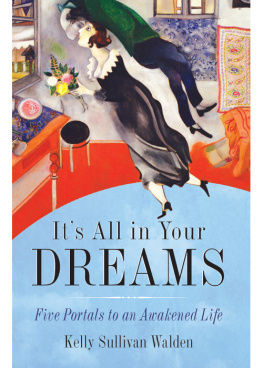INTO
YOUR
DREAMS
D ECIPHER Y OUR
Unique Dream Symbology
TO T RANSFORM Y OUR W AKING L IFE
Janece O. Hudson, EdD

DEDICATION
In loving memory of Elsie Sechrist
Friend, mentor, and second mother
Copyright 2011 by Janece O. Hudson
All rights reserved.
This book, or parts thereof, may not be reproduced in any form without permission from the publisher; exceptions are made for brief excerpts used in published reviews.
Published by
Adams Media, a division of F+W Media, Inc.
57 Littlefield Street, Avon, MA 02322. U.S.A.
www.adamsmedia.com
ISBN 10: 1-4405-1267-1
ISBN 13: 978-1-4405-1267-4
eISBN 10: 1-4405-2503-X
eISBN 13: 978-1-4405-2503-2
Printed in the United States of America.
10 9 8 7 6 5 4 3 2 1
Library of Congress Cataloging-in-Publication Data
Hudson, Janece.
Into your dreams / Janece O. Hudson.
p. cm.
Includes index.
ISBN 978-1-4405-1267-4
1. Dream interpretation. I. Title.
BF1091.H83 2011
154.63dc22
2011010230
Readings on pages 12, 13, 53, 119, 141, and 142 are from the Edgar Cayce Readings 1971, 19932005 by the Edgar Cayce Foundation. All Rights Reserved.
Many of the designations used by manufacturers and sellers to distinguish their product are claimed as trademarks. Where those designations appear in this book and Adams Media was aware of a trademark claim, the designations have been printed with initial capital letters.
This book is available at quantity discounts for bulk purchases.
For information, please call 1-800-289-0963.
Acknowledgments
I owe special thanks to many people, especially to those students, colleagues, clients, friends, and fellow dream workers who cant be named because they so graciously allowed me to use their dreams anonymously (with some details altered). My husband was extremely helpful as I was writing this book, and I appreciate his loving and generous spirit, as always. My editor, Katie Corcoran Lytle, was the epitome of patience and helpfulness and a joy to work with, as were all the folks at Adams Media. Wendy Simard deserves a medal. Huge thanks go to the following people (listed alphabetically by first name) for special acts of friendship, support, and/or information-sharing along my lengthy dream path: Anice Bullock, Anne Marie Palmer, Belle Johnson, Bess Harris, Carol Willis, Christie Craig, Deenie Cuenod, Dot Miller, Doug and Ida Stringfellow, Elizabeth Milstead, Gloria DesRoche, Jan Yonkin, Joyce Kaufmann, Linda Vandyck, Lynn Kurth, Lynn Turner, Mary Canada, Nadean Philips, Nancy Royal, Norma Jean Fredrickson, Pat Rosenblad, Pearl Lefevers, Sharon Werner, and Shirley Coleman. For those Ive inadvertently omitted, forgive my brain blip; I salute you.
Introduction
Did you dream last night? If so, you contributed to more than a billion storiesdreams from the unconscious mindthat were created in bedrooms across the United States. All of them were unique, many of them vitally important for the people who dreamed them. However, lots of people dont recall or pay little attention to these nighttime stories. Have you been one of them? By ignoring your dreams, did you fail to heed a message to slow down and pay attention to your health? Did you miss the stock tip that could have made you rich or the creative idea that could have made your life a thousand times easier? Did you miss a key to greater happiness and fulfillment in your relationships?
Learning to tap that wondrous inner source of wisdom and to work with your dreams is one of the greatest gifts you can give yourself. The worlds finest diagnostician, market analyst, creative thinker, sage, and counselor is as close as your pillow.
The advice is free, but deciphering it takes a bit of effort.
Thats what this book is aboutdeciphering your unique dream symbology to transform your waking life.
THE PERSONAL NATURE OF DREAMS
Dreams fascinate almost everyone, going back as far as the second century A.D. when a Greek named Artemidorus penned Oneirocritica, his treatise on dream interpretation. Psychologists have constructed elaborate theories to explain the mysterious content of dreams; other analysts, more arcane and less scientific, propose their own sets of meanings to dream symbolismmany of which strain credibility or become unbelievably complex. All strive to make sense of the process in books filled with incomprehensible psychobabble or dictionaries of outlandish definitions for various dream elements.
But dreams are not one-size-fits-all. They are unique creations by you, about you, and based on your individual experiences. They are messages from your unconscious mind, and you are the best interpreter of your dreams. Of course, because we all share a culture, many of our symbols may be similar, but we bring our own meaning to them. For example, my feelings about an airplane may be very different from yours if Im phobic about flying and you love air travel.
Interpreting dreams is not merely solving an interesting mind puzzle. After you figure out what your dreams mean, you have to apply the information to understand yourself and your behavior; make better choices; improve relationships; tend to your physical, mental, and spiritual health; and grow into the best person you can be. Thats working with your dreams.
Into Your Dreams is an easy-to-read, common-sense approach to interpreting and working with your dreams, grounded in contemporary scientific research yet expansive enough to include viewpoints that run the gamut from behavioral psychologist B. F. Skinner to the psychic Edgar Cayce. Not everybody, even scientists and researchers, agrees about the nature of dreams and the unconscious. Some suggest that dreams are mere random bits of memory popping up with the firing of synapses in various parts of the brain and the content is of no particular significance. For others, the content is everything. Clearly, both the biology and physiology of dreaming and the content are important. Although the biological aspect is fascinating (and youll get that occasionally), here well be dealing mostly with dream content.
I still remember a vivid dream from my childhood, so you can say that Ive been working with dreams most of my life. More specifically, Ive been formally pursuing the study of dreams and working with dreamers for nearly forty years. Ive worked with dream groups, led seminars, taught college classes, and done scores of presentations on the subject. My graduate training was in counseling and educational psychology, my doctoral dissertation was on dreams, and Ive published academic work in the field.
I still work with my own dreams regularly, and over the years Ive come to like the notion of using dreams to understand our needs as defined by Abraham Maslow. Maslow was a popular humanistic psychologist whose paradigm of the hierarchy of needs is used frequently in the fields of psychology, business, education, and medicine. He suggested that needs range from the most basic physiological needs to transpersonal being needs (more on this in ).
Using Maslows notion of needs and an amalgam of other sources, you will discover that dreams are sometimes physical, sometimes mental or emotional, sometimes spiritual or transpersonal. Some dreams are funny, some mundane, some profound. They range from admonitions to eat more spinach to encouragements to reach for the stars. All are important.







